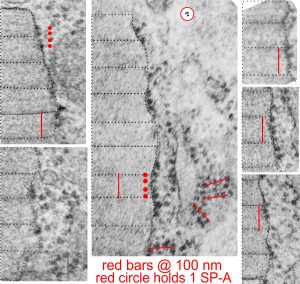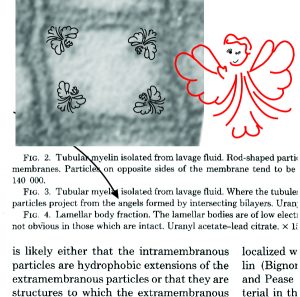There are several samples of the banding periods and growing end ribosomes, along with a tangential portion showing a grid arrangement of ribosomes on what I presume is an RER profile that contains an abundance of surfactant protein A. The relative sizes marked in black dotted lines are the intervals seen in each separate period of the bands (visible either as 3, 5, 7, or sometimes 9 separate bands) and a bar marker in red (which is the approximate equivalent of the total period (100 nm) and a sample from the internet of a shadow cast molecule of surfactant protein A — in a tiny circle (red circle, white background) which was estimated by the authors to be about 20 nm, Relative to the width of the micrographs which I have used in this image, the single surfactant molecule is sized accordingly. Because the surfactant A protein was shadow cast it appears more defined that would be seen in reality.
Monthly Archives: April 2016
3 ribosomes – per period, four for a complete band
I used an image with a tangential section on the growing end of the protein found in some alveolar type II cells, where clearly the ribosomes were aligned (not in spirals) in a grid. Using the pretty standard measurement of 100 nm for the distance between major dense bands in the periodicity found in these protein aggregations within the RER, it seems that in a complete period, dense to dense band there are four ribosomes (4 ribosomes per 100 nm) and if one calculates the continuous stacking of these bands (rather than having each period bound individually by RER membranes) then it becomes 3 ribosomes. The number of ribosomes found in routine sections along the leading edge of protein production is approximately 1.7/period (when counting hundreds of sites, and two species of mammal). The count just in this particular image along the leading edge is @1.6 ribosomes, while measured from the tangential grid of ribosomes, it is 4 per 100 nm.
Images from ferret alveolar type II cells give a little more information about the ribosomal organization, as they are more regular and banding is more easily seen, profiles are more orderly, whereas images from guinea pig intracisternal bodies are more often curved, with the banding crossing, or being circular and disorderly, and also there are larger composites of banding patterns. In mongrel dogs… there is typically a single period with 7 bands…. (in some sense the dog intracisternal bodies resemble a little bit… the birbeck granules in Langerhans cells). Here is the image used for these numbers.
(red lines are @ 100 nm, centered over contiguous ribosomes, the 100 nm length was calculated from the mean of the proximate banding patterns, shown in dotted lines)
I’ll trade my soul
Sara Louise Miller Witt
7 17 2015
You devour my spirit
so completely
that my resistance
just feels wrong
like when my eyes
feast on those gorgeous lips
that live in my head
when you’re gone
I’ll respire your struggles
into my breaths
despite the layers
someone stripped away
and if this love can’t
take care of the rest
I’ll trade my soul
for what yours can’t pay
Verge of a Dream: If i cut my hair and…
02 05 2008
If I cut my hair
And between the
Fingers, pinch the line
Hoping it reaches
Far away into
The ancient past,
Running down the
Orange and red
Silk dress edge,
And the marble
Shudders and what
Was resolved, does
Not fall, it yields
And warms like
The morning light
Of melted butter.
With each plea and
Promise, with each
Wish for words to
Give love its confidence,
Like a reel skipping
along
Leaving nothing permanent
On a blankened wall.
With each month or
Cloud that passed in
Distraction, the shelves
Unburdened, a chance
An interlude, lacy minutes
Could have come
And gone, the melting
Glass taking in
The air, inspiring,
a cooling curve
That rings then
With passion
RLB
Maybe only 2 ribosomes per period at the growing end of intracisternal bodies?
I found another set of very organized (grid style) ribosomes at the growing end of what is likely a profile of RER which contains the layered protein I think might be surfactant protein A (in over-production). More data are being gathered. Here is yesterdays video with the second tangential set of a dozen or more ribosomes added.
Since the size of surfactant protein A is about half that of the proposed width of a period (the 3, 5, and 7 sometimes prominent layers that general run parallel to the long axis of the RER cisterna (but not always) it would be really convenient to think that just on either side of the dense band there is a ribosome that is producing the protein. That would be too tidy for words.
Three ribosomes @ every 100 nm or just 2?
Here is a tangential view of the end of an intracisternal body in a type II cell of a ferret which shows, opportunely, an area of about 45 ribosomes (which would be producing the protein within the RER I am calling an intracisternal body, or a granule. This is an educated guess, since what is behind or in front of the tangential is not really visible, but can be assumed. I am quite certain the original block for transmission electron microscopy has been cut past this field. The grid overlay in this animation shows the spacing of about 3 ribosomes @ 100 nm. This is not a complete match for the number of ribosomes I had counted on the growing end of an intracisternal body, which was inbetween 2 – 4, 2 for an incidentally cut period, and 4 for the most opportune.
What is amazing is the regularity of their assembly here, and their regularity in size.
Protein organization within RER of type II alveolar cells – mongrel dog
Decades (literally) ago when I began trying to figure out what this organized protein was in type Ii cells, I received some peripheral canine lung tissue from from a researcher whose name I actually don’t remember. Several blocks were processed as for routine transmission electron microscopy and occasionally a type II cell would show cisternae of RER which had a protein that was organized in layers similarly to the intracisternal bodies in ferret and guinea pig. Picture is below. Intracisternal space with paracrystalline protein organized parallel to the long axis of the RER membrane, cyan; funny organization of something (too small to be ribosomes) at the end on the left, green; lamellar bodies, gold; ribosomes, purple. No nuclear or mitochondrial profiles are in this cropped image of a type II alveolar cell.
What you get, what you think you will get!
Cutest typo ever, ha ha…. angels, angles
Reading a paper by RJ Hassett, W Engleman and C Kuhn, III, talking about extramembranous particles in tubular myelin in rat lung (J Ultrastructure Research 1980) I was reminded of how difficult it is to publish a perfect paper. The images in this publication are very nice, and I have used this as a reference in the manuscript i am creating on intracisternal protein in some alveolar type II cells, where I am hunting for clues as to the protein involved in the layering seen in the electron micrographs. I ran onto this typo (way before the days of “autocorrect” so this was missed to the proofreaders and the publisher)… angels for angles. Love it. I am sure there would be a host of posts on typos in my papers. ha ha… but this was too cute to not bring your attention.
Is there a periodicity to the central band (of 7 or 9) found in guinea pig type II pneumocytes?
I am still working to determine the nature of the protein inclusion in the rough endoplasmic reticulum of some type II pneumocytes (alveolar type II cells) in guinea pigs from an experimental series that was conducted in the 1980s testing whether toluene diisocyanate was harmful for human health. These protein inclusions, I am hoping are going to turn out to be indicators of overproduction of surfactant protein A, or maybe D, though less likely SP-D, because SP-A is the most abundant surfactant protein in lung according to many reports). The protein itself, appears to be so organized I have called paracrystalline, and has not to my knowledge been described in detail, save for a couple of brief descriptions in the early 1980’s literature.
The protein displays several bands, typically parallel to the long axis of the rough endoplasmic reticulum membrane boundaries, which I have shown before, but in this short video clip I have examined the possibility of their being a periodicity to the protein, in the parallel axis to the membranes of the RER, by superimposing five images, removing the light (background) areas, and increasing contrast in the dark areas.
If one accepts that the distance from one dark band to the other (in this case the plasmalemma) is 100 nm, then I think there is a relatively obvious periodicity of about 4 dense areas within the central band (middle between two dark bands), that is, within about the same 100 nm length.




